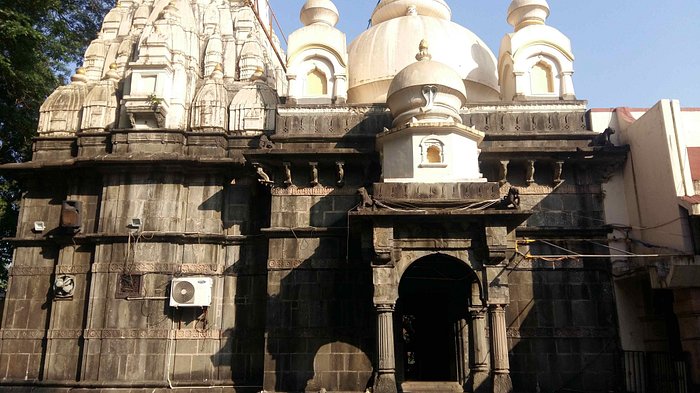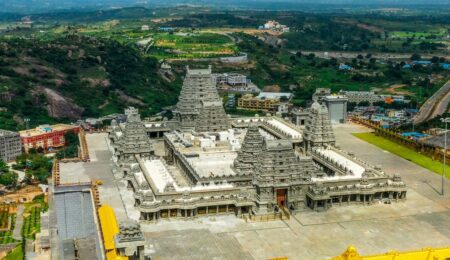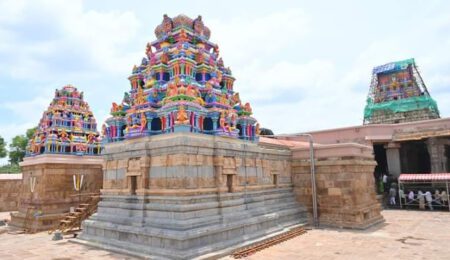The Shree Vajreshwari Yogini Devi Mandir: A Fortified Shrine of Maratha Valor and Geothermal Mysticism
The Shree Vajreshwari Yogini Devi Mandir stands as a powerful testament to the intersection of ancient Shakti worship, Maratha military history, and unique geothermal phenomena in the heart of Maharashtra. Located approximately 75 km from the metropolis of Mumbai, this important Hindu temple is dedicated to Goddess Vajreshwari, an incarnation of Parvati. The site not only serves as a vital pilgrimage center but also anchors a wider region known for its curative hot springs and deep spiritual history.
Strategic Digital Positioning and Core Identity
The digital presence of the Vajreshwari Mandir must cater to diverse audiences, spanning devotees seeking spiritual fulfillment, history enthusiasts interested in the Maratha Empire, and wellness tourists drawn to the site’s unique geothermal features. To maximize its reach, the content focuses on location-specific, high-intent terms that capture the essence of the site beyond generic travel planning. Key phrases used for visibility center on the temple’s full official name (Shree Vajreshwari Yogini Devi Mandir), its location near metropolitan hubs (Vajreshwari Temple Mumbai), and its unique geographical and historical attributes (Chimaji Appa Vajreshwari Temple, Vajreshwari hot springs). This ensures that travelers planning a specific pilgrimage, those researching historical events, or individuals seeking wellness destinations are directed efficiently to this resource.
Shree Vajreshwari Yogini Devi Mandir: An Introduction to the Goddess and the Holy Site
The temple is physically located in Vajreshwari town, which falls within the Palghar District of Maharashtra. Its precise geographic coordinates are 19°29′12″N 73°1′33″E.1 While the area is often associated with Mumbai due to its proximity (75 km), the site maintains a distinct regional identity, situated on the banks of the Tansa River.
The town was originally known as Vadvali but was later renamed Vajreshwari in reverence to the presiding goddess. The temple is established on the Mandagiri hillock, which is an important geological feature formed by an ancient volcanic eruption, lending a distinctive, rugged landscape to the surroundings. The hillock’s volcanic nature is crucial, as it provides the underlying cause for the region’s famous hot springs.
The antiquity of the site is further established through Puranic texts, which refer to Vadvali as a region visited by the Vishnu avatars Rama and Parashurama. One tradition suggests that Parashurama performed a yajna (fire offering) in Vadvali, and the surrounding hills, composed partly of volcanic ash, are regarded by locals as the remnants of this massive, sacred ritual. The shift from the Puranic reverence for Vaishnava deities (Rama, Parashurama) to the subsequent dedication to Vajreshwari (a Shakta deity) highlights a historical evolution in the region’s spiritual focus, moving toward Goddess worship while still honoring the deep antiquity associated with the site’s original name.
Vajreshwari Temple Fact Sheet
| Key Attribute | Detail | Source Context |
| Presiding Deity | Goddess Vajreshwari (Yogini Devi) | Incarnation of Parvati/Shakti |
| Location | Vajreshwari Town, Palghar District, Maharashtra | 75 km from Mumbai |
| Temple Creator | Shreemant Chimaji Appa | Maratha military commander |
| Construction Year | Completed 1739 | Following Bassein Fort conquest |
| Geographic Feature | Mandagiri Hillock | Formed by ancient volcanic eruption |
Layers of Legend: Mythology and the Origin of Vajreshwari
The goddess Vajreshwari derives her formidable name from the Sanskrit words Vajra, meaning “thunderbolt,” and Ishwari, meaning “goddess.” She is thus known as the Goddess of the Thunderbolt, reflecting the immense power associated with her legends.
The primary mythological account, rooted in the Shakta tradition, describes a conflict between the celestial beings (Devas) and the demon Kalikala. Kalikala possessed the ability to neutralize or shatter any conventional weapon thrown at him. In the climax of the battle, Indra hurled his most powerful weapon, the Vajra (thunderbolt), but Kalikala managed to break it into fragments. It was from the boundless energy of the shattered Vajra that the Goddess emerged, subsequently destroying the demon. The Devas, in awe of her appearance and decisive action, extolled her as Vajreshwari.
An alternative local tradition provides a different origin for her name, asserting that Mata Parvati took an Avatar specifically to protect the ancient Rishi Vashistha from a Vajra dispatched by Indra. To completely neutralize the weapon’s destructive force, Parvati swallowed the Vajra, thereby earning the epithet Vajreshwari. Upon the request of Shree Ramchandra, she consecrated the site as her permanent home.
The spiritual history of the region is further enriched by its status as Nath Bhoomi, a land sacred to the Nath Sampradaya. The Navanath Kathasar explicitly records that the revered Nath Yogi Machindranath served the goddess Vajrabhagawati (Vajreshwari) for an entire month. This service involved a profound, daily ritual: bathing the Goddess using hot water that Machindranath is said to have miraculously created himself. This powerful narrative provides a deep spiritual explanation for the presence of the hot springs, positioning the geothermal phenomenon as not merely a geological accident but as a direct result of ancient divine and yogic power, reinforcing the sanctity of the water for pilgrims.
The Maratha Legacy: History and the Peshwa Vow
The current imposing structure of the Vajreshwari Temple is a direct result of the expansion and military successes of the 18th-century Maratha Empire. Its creator was Shreemant Chimaji Ballal Peshwa (1707–1740), the younger brother and military commander of Peshwa Baji Rao I. Chimaji Appa was instrumental in driving out European powers from the western coast of India, focusing his energy on capturing the strategically vital Bassein Fort (Vasai), which had been held by the powerful Portuguese for years and had resisted Maratha conquest for over three years.
In 1739, while setting up his military camp near the Vadavali region during the extended campaign against Vasai, Chimaji Appa prayed devoutly to Goddess Vajreshwari. He made a solemn vow: if he successfully conquered the Bassein Fort and defeated the Portuguese forces, he would ensure the construction of a grand temple dedicated to the goddess. According to tradition, the goddess answered his prayer, appearing in his dream to provide critical tactical guidance on how to breach the fort’s defenses.
The strategic guidance proved effective, and the Bassein Fort fell on May 16, 1739, securing a landmark Maratha victory over the Portuguese regime. To celebrate this conquest and fulfill his vow, Chimaji Appa immediately ordered the new Subhedar (Governor), Shankar Keshav Phadke, to build the new Vajreshwari Temple. Appa’s promise was to build a structure that was “fort-like”, and the resulting architecture reflects this military genesis. The temple stands not just as a place of worship but as a permanent monument to a major military triumph, linking the goddess directly to the rise of Maratha power.
The architectural elements of the temple further emphasize this historical connection. The main entrance gate features a Nagarkhana (drum house) built by the Gaikwads of Baroda, whose design clearly draws inspiration from the entrance of the recently captured Bassein Fort. Furthermore, Nanasaheb Chandavadakar, a wealthy Nashik moneylender, sponsored the construction of the prominent stone steps leading up to the shrine and the stately Dipamala (tower of lights) in front of the structure, reflecting broader Maratha patronage across the empire.
Architectural Profile of Mandagiri Hill: A Fortified Shrine
The Shree Vajreshwari Yogini Devi Mandir is characterized by its robust, fort-like architecture, enclosed by a stone wall that evokes a defensive structure. Visitors approach the main shrine by ascending a series of 52 stone steps.
An important devotional feature is visible on one of these steps: a golden tortoise is carved into the stone, an image worshipped as Kurma, the tortoise incarnation of the god Vishnu. The deliberate placement of this symbol of cosmic stability, rooted in Vaishnava tradition, within a dominant Shakti site demonstrates the sophisticated religious syncretism prevalent during the Maratha period, integrating various divine forms under a unifying spiritual umbrella.
The main shrine itself is structurally divided into three primary sections. The innermost chamber is the Garbha gṛha (main inner sanctum), which houses six principal idols. Immediately outside this, a secondary sanctum contains idols dedicated to Ganesha, Bhairava, Hanuman, and the local deity Moraba devi. The final section is the pillared Mandapa (assembly hall), featuring a bell that devotees ring upon entering the sacred space, and a marble lion statue, which represents the goddess Vajreshwari’s traditional mount.
Beyond the main temple complex, the grounds include a Yajna kunda (a structure for fire offerings) situated outside the assembly hall. Numerous smaller shrines are dedicated to other significant deities, including Kapileshwar Mahadeva (Shiva), Datta, and Hanuman. The site also pays homage to the local spiritual history of the Giri Gosavi sect: a Peepal tree in front of the Hanuman shrine is worshipped as Ganesha due to its distinct, naturally assumed form, and the samādhi (tomb) of the 17th-century Giri Gosavi saint Godhadebuwa is situated nearby on the Gautam hill.
The Thermal Paradox: Sacred Hot Springs of Vajreshwari, Akloli, and Ganeshpuri
One of the most distinguishing features of the Vajreshwari region is its profusion of natural hot springs, a geographical anomaly directly attributed to the town’s location at the foot of the Mandagiri hillock, a structure formed by an ancient volcano. These thermal springs extend for approximately 7 km along the bed of the Tansa River, with the most famous clusters found in Vajreshwari town itself and the nearby villages of Akloli and Ganeshpuri. The water temperature in these springs is remarkably high, fluctuating between 43°C and a potentially scalding 80°C.
Mythologically, these waters are tied directly to the goddess’s power. One tradition holds that the hot water is the blood of the demons and giants slain by Vajreshwari, symbolizing purification through conquest. Another spiritual justification, stemming from the Nath Sampradaya, attributes the waters to Machindranath, who personally created the hot springs to perform the ritual bathing of the goddess. Pilgrims often take a holy bath in the waters, which are captured in Kundas (tanks) named after significant deities and figures such as Surya, Chandra, Agni, Vayu, Rama, Sita, and Lakshmana, ritualizing the cleansing process.
The cluster of springs at Akloli is particularly well-known, where seven hot springs are channeled into cement tanks used by pilgrims. Traditionally, these thermal waters are believed to possess curative and medicinal properties, used throughout history for spiritual healing and treating physical ailments. This ancient understanding of hydrotherapy aligns with global traditions, as the importance of sacred waters for healing has been documented since Vedic and Greek antiquity.
In contemporary times, the scientific study of the Vajreshwari and Ganeshpuri hot springs has provided a modern confirmation of their uniqueness. Researchers have explored the thermal environments, isolating various thermophilic microorganisms, including strains of Bacillus licheniformis, which thrive in high heat. These unique microbes are currently being studied for their potential in biotechnological applications, specifically for isolating valuable enzymes like amylase and cellulase. Thus, the site maintains a dual significance: its sacred thermal waters offer spiritual healing and renewal to pilgrims, while simultaneously presenting a vital area for bio-scientific research and innovation, grounding the ancient claims of “curative powers” in modern chemical and biological reality.
Pilgrimage and Annual Observances
The ritual calendar of the Shree Vajreshwari Yogini Devi Mandir is rich, centered around the worship of the Goddess and the cycle of the Hindu lunar year.
The temple’s most significant annual event is the Chaitra Amavasya Yatra (fair), held in honor of the Goddess on the Amavasya (new moon day) of the Hindu month of Chaitra (March/April). This fair is preceded by ceremonial worship of the Goddess, beginning on the 14th day of the waning moon. On the night of Amavasya, lamps are worshipped, marking the deep spiritual significance of the transition to the new moon. The following day, which marks the first day of the Hindu month Vaisakha, features a grand ceremonial procession (Palkhi) carrying an image of the goddess through the town, concluding with the distribution of Mahaprasad to all assembled devotees.
The selection of Chaitra Amavasya for the main fair is highly strategic, as this day marks the first new moon of the Hindu lunar calendar. The day is considered extremely auspicious for engaging in rituals aimed at spiritual healing, achieving clarity, seeking absolution from sins, and performing ancestral rites. The Yatra therefore functions as a critical moment of annual spiritual cleansing and cosmological renewal for devotees, further amplified by the tradition of taking a holy dip in the thermal springs.
The temple also enthusiastically celebrates the two primary annual Navaratri festivals (nine nights dedicated to the Goddess): Chaitra Navaratri, culminating in Ram Navami, and the post-monsoon Sharada Navaratri, culminating in Vijayadashami. Other important festivals celebrated throughout the year include Shiva worship during the month of Shravana, Kojagiri Poornima, Diwali (festival of lights), Holi (festival of colours), Datta Jayanti, Hanuman Jayanti, and the birthday of the revered local saint, Godhadebuwa Jayanti.
The daily ritual schedule is meticulously followed, providing crucial planning information for visiting pilgrims:
Daily Ritual and Aarti Timings
| Time | Ritual Name | Details |
| Morning 5:30 AM | Temple Opening and First Aarti | Commencement of the day’s worship |
| Midday 11:15 AM | Second Ritual / Aarti of Goddess | Midday prayers and offerings |
| Midday 11:30 AM – 12:00 PM | Naivedya Timings | Offering of consecrated food |
| Evening 7:00 PM | Paadha Pooja (Evening Ritual) | Evening worship ritual |
| Evening 8:15 PM | Evening Aarti | Main evening devotional service |
| Night 9:00 PM | Final Ritual and Temple Closed | Conclusion of daily worship |
Vajreshwari: Planning Your Pilgrimage and Local Connections
Vajreshwari is conveniently accessible from Mumbai and surrounding areas of Maharashtra, positioning it as a popular day-trip or weekend pilgrimage destination. Travel logistics indicate that the town is 27.6 km from the nearest major Western Railway station, Virar, and 31 km from Khadavli on the Central Railway line.
For travelers, the Vajreshwari Temple serves as the nucleus of a richer, integrated spiritual and eco-tourism circuit. Visitors frequently combine their trip with excursions to nearby spiritual and geographical centers:
- Ganeshpuri: Located close to Vajreshwari, Ganeshpuri is essential for thermal and spiritual tourists, hosting further clusters of hot springs. Ganeshpuri is also home to the Gurudev Siddha Peeth, a highly regarded spiritual retreat and meditation center established by Swami Muktananda in the 1950s, as well as an ancient Shiva Temple on the Tansa River.
- Tungareshwar: This area offers both the ancient Tungareshwar Temple dedicated to Lord Shiva, situated atop the Tungareshwar Hill, and the Tungareshwar Wildlife Sanctuary, covering an area of approximately 85 square kilometers.




Leave a Comment